|

|
|
|
|
I don't know how others manage, but the holidays really wreak havoc
with my blogging. And, they make it difficult with my keeping up
with other blogs. Well, the new year is upon us, and life
settles back down to a routine that, once again, allows me to renew my
participation on a (more or less) full time basis. --df
Tuesday,
January 10, 2006
 A
Sensible Backcountry "Management" Plan for Grand Canyon
- I am
not much of one for New Year's resolutions. But, I do tend to
contemplate on my life and what it is I want
to do. One thing I want to do more of is backpack in the Grand
Canyon. I have logged many thousands of miles during over 200
trips and nearly 300 nights spent camping in the backcountry.
But, I have only done one overnight backpacking trip into the canyon
over the last two years (2004-2005). I consider the Grand Canyon
as my number one hobby, and I also actually get some mileage out of it
insofar as research (that helps me maintain my academic credentials at
the university). So, while I did do many fantastic day hikes
last year, I was really up for a big trip. In large part, this
was accommodated by a mild winter
A
Sensible Backcountry "Management" Plan for Grand Canyon
- I am
not much of one for New Year's resolutions. But, I do tend to
contemplate on my life and what it is I want
to do. One thing I want to do more of is backpack in the Grand
Canyon. I have logged many thousands of miles during over 200
trips and nearly 300 nights spent camping in the backcountry.
But, I have only done one overnight backpacking trip into the canyon
over the last two years (2004-2005). I consider the Grand Canyon
as my number one hobby, and I also actually get some mileage out of it
insofar as research (that helps me maintain my academic credentials at
the university). So, while I did do many fantastic day hikes
last year, I was really up for a big trip. In large part, this
was accommodated by a mild winter 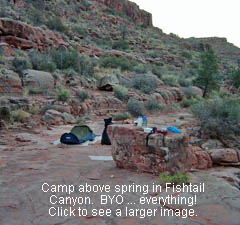 and
easy access to North Rim viewpoints (although the paved highway is
closed, the Forest Service roads are open, and some are regularly
plowed/graded). So, this past Wednesday, I was off to the canyon
for a five day trek in the area of Fishtail Mesa, which I will add to
my blog in the coming days ... and
easy access to North Rim viewpoints (although the paved highway is
closed, the Forest Service roads are open, and some are regularly
plowed/graded). So, this past Wednesday, I was off to the canyon
for a five day trek in the area of Fishtail Mesa, which I will add to
my blog in the coming days ...
I did spend some time thinking about canyon-related issues, which is
inevitable when you must spent upwards of 12 hours a day in your
sleeping bag because it is cold and dark! Daytime temps were
great - in the 60s, but overnight lows were close to freezing.
One of these issues I revisited in my head is the crazy way in which
the National Park Service tries to micromanage the Grand Canyon
backcountry user, and the awful incentives they have for improved
service. In consideration of these issues, I would like to
propose a plan that is less intrusive and more flexible than the
current state of affairs, and that doesn't degrade the backcountry for
others to experience.
 Only require
permits for improved campgrounds.
I have always thought it was silly to give out permits for the Indian
Garden, Bright Angel and Cottonwood campgrounds without any charge, as
was done in the past (before 1997). These have treated water,
individual campsites, picnic tables, pack bars and decent restroom
facilities. All of these services are valuable and I have no
problem paying for them.
Only require
permits for improved campgrounds.
I have always thought it was silly to give out permits for the Indian
Garden, Bright Angel and Cottonwood campgrounds without any charge, as
was done in the past (before 1997). These have treated water,
individual campsites, picnic tables, pack bars and decent restroom
facilities. All of these services are valuable and I have no
problem paying for them.
But, why should someone pay exactly the same
price for a permit to spend two nights in the Bright Angel campground
as they would to spend two nights at Tanner Rapids? At Tanner
Rapids there are no facilities of any kind and this is at the foot of
a trail that the Park Service fixes up only on an irregular
basis. Well, the simple answer is that one shouldn't have to pay
the same price for these two vastly different sets of conditions.
 To charge
more backpackers, the park service will have to provide improved
facilities.
There are a host of sites in the Grand Canyon that can really use an
upgrade in this regard - Deer Creek, Thunder River, Horseshoe Mesa,
Hance Rapids, Tanner Rapids, Hermit Rapids, and Clear Creek all come
to mind. All of these sites can be congested, and without
suitable facilities they do get degraded. One look at (or, whiff
of) the awful vault toilet in Deer Creek convinced me to head for
higher ground to do my business. So, to collect revenue from
these backpackers, the facilities will have to be vastly
improved. This not only improves the condition of the site, it
also improves the experience of the backpacker to these more remote
locales within the canyon.
To charge
more backpackers, the park service will have to provide improved
facilities.
There are a host of sites in the Grand Canyon that can really use an
upgrade in this regard - Deer Creek, Thunder River, Horseshoe Mesa,
Hance Rapids, Tanner Rapids, Hermit Rapids, and Clear Creek all come
to mind. All of these sites can be congested, and without
suitable facilities they do get degraded. One look at (or, whiff
of) the awful vault toilet in Deer Creek convinced me to head for
higher ground to do my business. So, to collect revenue from
these backpackers, the facilities will have to be vastly
improved. This not only improves the condition of the site, it
also improves the experience of the backpacker to these more remote
locales within the canyon.
 For
the rest of the backcountry, ask users to file "hiking
plans."
This way, the park can collect data on backcountry use and utilize
this to plan for continued improvement in campsite facilities if the
demand warrants (say, at Nankoweap, or Boucher Creek, or along the
South Bass Trail or the North Bass Trail). In these more
primitive areas of the canyon, there are few maintained trails and
hiking itineraries are harder to maintain.
For
the rest of the backcountry, ask users to file "hiking
plans."
This way, the park can collect data on backcountry use and utilize
this to plan for continued improvement in campsite facilities if the
demand warrants (say, at Nankoweap, or Boucher Creek, or along the
South Bass Trail or the North Bass Trail). In these more
primitive areas of the canyon, there are few maintained trails and
hiking itineraries are harder to maintain.
The hike I did last week involved two rather
dramatic itinerary changes, one the day before I left for the hike and
the other on the second day of the trek. I had planned to hike
around Fishtail Mesa, counterclockwise. But, uncertainty about
water sources led me to change the direction to clockwise, with a
first night stop at Fishtail Spring. But, on the second day,
hauling 10 quarts of water, and making slow progress, I decided to
abandon my hike around the mesa and, instead, climb a saddle into the
Indian Hollow drainage, where I spent three nights camped on the
Esplanade in the Kanab Wilderness Area (which doesn't require a
permit). It is not only impractical for the park service to
insist that backpackers in these more remote regions stay on their
itineraries, it can be downright dangerous. When I am hiking,
conditions affect my decisions about exactly what course to follow.
The bottom line here is that the park service will still earn just
about as much revenue as before, since by and far most backpackers use
the well-maintained campgrounds at Indian Garden, Bright Angel and
Cottonwood. But, the park service will now have an ongoing
incentive to provide better services to highly used areas,
incorporating them into this group of well-maintained sites.
And, backpackers that are more adventurous and yearn for the sparse
and spartan fringes of the backcountry would have less incentive to
conceal their activities from the park service.
|
|

|
|
Wednesday,
January 11, 2006
 The
New Digs
-
Starting a few years ago, plans were made to rebuild the College of
Business Administration at Northern Arizona University, where I
teach. Monday we had our first day in the new building. We
had to box up all our stuff (throwing out as much as possible, and
much was possible) before handing in our keys to the old building by
December 23. Professionals moved this to our new buildings, and
all my stuff came through unscathed.
The
New Digs
-
Starting a few years ago, plans were made to rebuild the College of
Business Administration at Northern Arizona University, where I
teach. Monday we had our first day in the new building. We
had to box up all our stuff (throwing out as much as possible, and
much was possible) before handing in our keys to the old building by
December 23. Professionals moved this to our new buildings, and
all my stuff came through unscathed.
My first, second, third and fourth impressions of the building ... I
was reminded of old time submarine movies, what with the metal
railings and concrete stairs and pillars and the unfinished
ceilings. That is the way it is supposed to look. I could
half close my eyes and hear claxons sounding, with the Dean bellowing
over the P.A. system (which we don't have), "Dive! Dive!
Dive!" Then, I had the impressions of a hotel. All
the faculty offices extend down the north side of the building, and we
each have sliding glass doors. So, as I stood at my office
(located on the west end of the third floor) I could see all these
door handles extending off into the distance. Then, I wondered
if we hadn't been relocated into the football stadium. The
unfinished look, the giant stairways, open space, and odd padding
under the stairs (see the second picture, below) made me feel like we
were in the concourse of a sports arena. And, fourth, as I was
standing alongside one of the railings, noting people on floors below
and above me, I was reminded of the movie, "I, Robot" where
the interior of the corporation that made robots had a large open
central space. Well, that's just me and the way I think.
It will be interesting to see how the building actually functions as a
college. There are great spaces for the students to spend time,
so they don't have to leave the building in between classes, or trek
up to the library. There are lots of informal meeting spaces
around (see some in the first photo), and some computer stations
located out in the hallways. So, that will be a giant plus for
them. On the other hand, the sound really carries, and once the
building is full of students, I suspect it will be hard to get much
meaningful work done in our offices, since we all front the huge
central space of the building. Still, every faculty office now
has a window to the world, so that is quite a change for those of us
that used to be relegated to interior office spaces in the old
building.
There is still some work being done to get ready for classes, which
begin next Tuesday. That morning, I have a class in the new
auditorium, and there is still a ways to go to get that space
ready. On April 21st the new building will be dedicated, with
all kinds of activities planned for that day. If you are a local
reader, stop by and check out our new digs.
| Click
on any picture to see a larger image. |
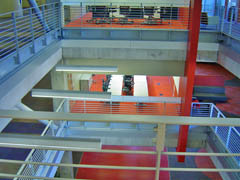 |
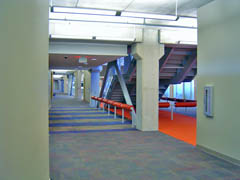 |
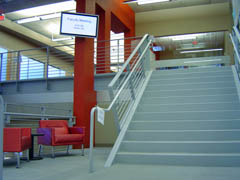 |
| Open
central core of building |
Floor
with that unfinished look. |
Central
stairway and monitor. |
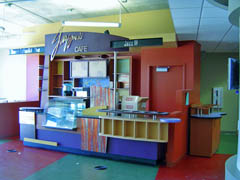 |
 |
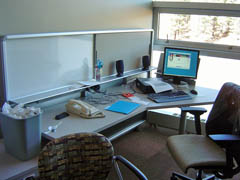 |
| A
coffee shop is a nice touch. |
My
office looking towards the hall. |
My
office ... has a window! |
|
|

|
|
Friday,
January 13, 2006
 Snow
Blind
-
Although the annual average snowfall in Flagstaff
(at 7,000 feet in elevation) is something over 100 inches, it seems to
me that we rarely have an average year. We either get inundated
with snow, like last year, or it is relatively dry, like this
year. I like dry years as they afford me the opportunity of
doing interesting hikes at the Grand Canyon on trails that would
otherwise be snowpacked, accessible along Forest roads that would
otherwise be impassible.
Snow
Blind
-
Although the annual average snowfall in Flagstaff
(at 7,000 feet in elevation) is something over 100 inches, it seems to
me that we rarely have an average year. We either get inundated
with snow, like last year, or it is relatively dry, like this
year. I like dry years as they afford me the opportunity of
doing interesting hikes at the Grand Canyon on trails that would
otherwise be snowpacked, accessible along Forest roads that would
otherwise be impassible.
But, for the owners of the Arizona
Snowbowl, the erratic snowfall (even though they are located a
couple of thousand feet higher than the city) makes the business one
of feast or famine. Just a few years ago, they were only open
for four days over the winter skiing season! So, they approached
the City of Flagstaff about using reclaimed water for the purpose of
snowmaking in order to better stabilize their season. The city
council accepted, and hearing were held by the Forest Service (which
controls the land). The Forest Service concluded that this use
would be acceptable. Of course, then the usual suspects
challenged the ruling and proceeded to federal court.
The Snowbowl owners agreed not to initiate the building of the water
pipeline and the rest of the snowmaking infrastructure until the court
challenges were settled. This past Wednesday, Federal District
Judge Paul Rosenblatt ruled
in favor of the Forest Service and Snowbowl. Here are some
snippets from that decision:
| Plaintiffs
have failed to demonstrate that the Snowbowl decision coerces
them into violating their religious beliefs or penalizes their
religious activity. (p. 56)
Plaintiffs
have failed to present any objective evidence that their
exercise of religion will be impacted by the Snowbowl
upgrades. (p. 56)
The Snowbowl
decision does not bar Plaintiffs' access, use, or ritual
practice on any part of the Peaks. The decision does not
coerce individuals into acting contrary to their religious
beliefs nor does it penalize anyone for practicing his or her
religion. (p. 58)
While
Plaintiffs may find it offensive that lands that have cultural
and religious significance to them also host recreational
activities, this cannot justify a "religious
servitude" over large amounts of public land. (p.
59) |
Well, you might think that was the end of this story. But, of
course, that isn't the case. Opponents have vowed to revisit
this issue before the Flagstaff City Council as well as block the
construction of the water pipeline to the Snowbowl. As far as
they are concerned, there is no end to this issue until they get what
they want.
Of course, most of the opponents (the Sierra Club, the Flagstaff
Activist Network and the Center for Biological Diversity were parties
to the lawsuit) to Snowbowl's upgrade and snowmaking really couldn't
care less about Native American religious practices. As the
judge ruled, these practices can, and are, accommodated on the San
Francisco Peaks. Instead, this is just a red herring. What
these groups really object to is homo sapiens. They detest human
use, and enjoyment, of the the outdoors. They consider humans to
be separate from nature rather than a part of nature. But, it is
in our "nature" to transform and use the world around us -
hence food, clothing and shelter. And, we also transform nature
in order to enjoy what it has to offer by building ski resorts, hiking
trails, floating rafts down rivers and flying helicopters over areas
of fantastic scenery.
In time, according to cosmologists, the sun will expand that burn away
the earth's atmosphere, and no amount of protesting will stop that
from happening. Much sooner, at least in geological time, we are
likely to get hit by an asteroid that will do damage that humans
couldn't possibly match, as occurred when the dinosaurs were ripped
out of the evolutionary progress of life on earth. Preserving
nature for that ultimate end is indefensible. Denying our nature
and our humanity is a philosophy that is as shallow as it gets.
Previous
blogs on this topic:
 Don't
Drink the ... Snow
Don't
Drink the ... Snow
 Cultural
Bigotry
Cultural
Bigotry
|
|

|
|
Sunday,
January 15, 2006
|

|
|
Panoramic
view of the Inner Basin of the San Francisco Peaks from the
summit of Mt. Humphreys.
Click on
the picture for a larger image. |
 Highest
Ranked Blogmeister in Arizona!
-
Well, highest ranked insofar as elevation is concerned, and maybe for
only about 20 minutes or so, and only yesterday ... when I hiked up to
the top of Mt. Humphreys, the highest point in Arizona. I love
this hike, and our extremely dry winter has made this trek possible
even at this late date. In fact, I was stymied on this hike last
June because of the enormous snowfall that still remained from last
winter! I left my truck at 8:03 am and reached the summit at
11:00 am, staying there for about 20 minutes. I returned to my
truck at 1:38, making this about a 5.5 hour round trip hike. It
was cold on the way up, but moderate to warm, low on the mountain, on
the return. The wind kicked up from the saddle to the top, and
it was fierce at the very top, practically able to push you
over! In fact, on the return, with the wind blowing in my face,
I wore ski goggles for about 20 minutes - until I lost enough
elevation to mitigate the worst of the wind.
Highest
Ranked Blogmeister in Arizona!
-
Well, highest ranked insofar as elevation is concerned, and maybe for
only about 20 minutes or so, and only yesterday ... when I hiked up to
the top of Mt. Humphreys, the highest point in Arizona. I love
this hike, and our extremely dry winter has made this trek possible
even at this late date. In fact, I was stymied on this hike last
June because of the enormous snowfall that still remained from last
winter! I left my truck at 8:03 am and reached the summit at
11:00 am, staying there for about 20 minutes. I returned to my
truck at 1:38, making this about a 5.5 hour round trip hike. It
was cold on the way up, but moderate to warm, low on the mountain, on
the return. The wind kicked up from the saddle to the top, and
it was fierce at the very top, practically able to push you
over! In fact, on the return, with the wind blowing in my face,
I wore ski goggles for about 20 minutes - until I lost enough
elevation to mitigate the worst of the wind.
| Click
on any picture to see a larger image. |
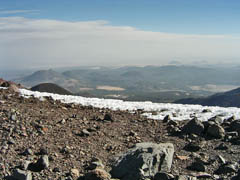 |
 |
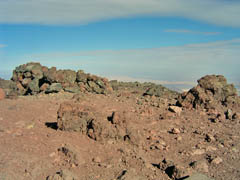 |
Residual
snow overlooking
the Sunset Crater area. |
Your
humble blogmeister - well
bundled against the cold and wind. |
Top
of Mt. Humphreys looking
to the north. |
|
|

|
|
Tuesday,
January 17, 2006
 Sauce
for the Gander
-
During the "big box" campaign last spring, the proponents,
largely funded by Wal-Mart, ran a newspaper ad that compared
restrictions against these stores as one step on a slippery slope to
more restrictions on the freedom of voluntary association. To
drive the point home, they used a photo that showed a book burning
scene out of 1930s Germany. There was no mention of Hitler nor
of Nazis. In fact, the book burners appeared to be members of
the S.A.,
the military wing of Hitler's political movement. Did the
analogy go too far? Well, it is a fair point to argue - today it
is shopping, tomorrow it is housing and, the next day, it is what you
can read.
Sauce
for the Gander
-
During the "big box" campaign last spring, the proponents,
largely funded by Wal-Mart, ran a newspaper ad that compared
restrictions against these stores as one step on a slippery slope to
more restrictions on the freedom of voluntary association. To
drive the point home, they used a photo that showed a book burning
scene out of 1930s Germany. There was no mention of Hitler nor
of Nazis. In fact, the book burners appeared to be members of
the S.A.,
the military wing of Hitler's political movement. Did the
analogy go too far? Well, it is a fair point to argue - today it
is shopping, tomorrow it is housing and, the next day, it is what you
can read.
Of course, no such discussion emerged from this ad. Instead,
there was sharp criticism of the mere use of Nazi-related imagery to
convey a political point. And, such use is usually a show
stopper, and likely to be more counter-productive to the side using
it. On this issue, the folks at the Friends
of Flagstaff's Future were all over it like a cheap suit,
lambasting Wal-Mart for stooping to such references. Wal-Mart
execs apologized for the ad, pulled it from the paper, and, as I
recall, canned the ad agency responsible for putting it
together. End of story? Of course not. The FFF won't
let this issue rest - at the showing of the anti-Wal-Mart movie, The
High Cost of Low Price (blogged about here),
the FFF brought along flyers showing the offensive ad, and their
executive director raised the issue in her introduction to the
movie. Apparently, whenever the question of Wal-Mart comes up in
the future, here in Flagstaff, this will be part of the story.
So, last week, a federal judge ruled in favor of allowing Snowbowl to
use reclaimed water to make artificial snow on its ski runs.
And, what did the opponents of this ruling have to say? As
quoted in the Daily Sun on Friday,
January 13, 2006 (p. 2):
| Opponents
called [Judge] Rosenblatt's decision a racist action
tantamount to "genocide."
"It is
another sad day in the history of ... the Navajo Nation ...
[where] genocide and religious persecution continue to be
perpetrated on Navajo people ..." Navajo Nation President
Joe Shirley Jr. said.
[Save the
Peaks Coalition member Klee] Benally's sister, Jeneda,
compared Rosenblatt's decision to the Holocaust, in terms of
legality. "When Hitler was in Germany, what he was
doing to the people there was considered legal..." |
And, where is the FFF on this issue? Or, the ragtag bunch at the
Flagstaff
Activist Network? Or, even the leaders of the Save
the Peaks Coalition? Nary a peep out of them so far.
And, don't hold your breath for any peeps any time soon.
|
|

|
|
Friday,
January 20, 2006
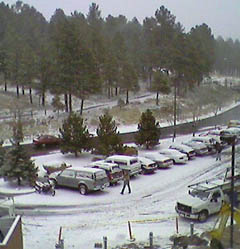  On
the Nature of the University and the Learning Process
-
On
the Nature of the University and the Learning Process
-
Yesterday, Flagstaff received its first
appreciable snow of the winter, and even that wasn't all that much, as
can be seen in the photo I took from my office in the new College of
Business Administration building on the campus of Northern Arizona
University. My old office didn't have a window, so now I am much
more aware of prevailing weather conditions (see The
New Digs). While
it was a modest snowfall, it came down hard and fast, and the
temperature dropped like a rock. And, it was quite sunny in the
hour before sunset, which led the streets to get very icy.
Traffic accidents were numerous in the late afternoon, as drivers
easily misjudged the severity of these conditions.
One of my classes this term is a large one - over a hundred students -
and held in an auditorium. Mostly they are freshmen and
sophomores. I decided to take the opportunity in yesterday's
class (the second one of this new spring semester) to give them what
one of my students later referred to as a "pep talk."
It encompassed a lot of my thinking about what it is that is actually
going on in this environment, and may serve as a springboard for later
blogs about what I think this environment really should look
like. I have condensed my talk down to the essentials, which I
hope the interested reader finds not too belabored.
|
Why
are you here?
The
university exists to promote your learning and to bestow upon
you certain credentials that, to the best of our ability,
attest to the level of education you have attained.
But, learning is an odd thing.
It occurs within you.
When you sit down to think about what really goes on
here, maybe 95% of it is happening on your side of the
classroom, not on my side ...
How
do you learn?
Well, if you really want to learn about the world, you must
read.
You must read all the time ...
[T]he oral
tradition has the advantage of convenience – it is much
easier to listen to me than it is to read a book ...
I am a pretty good talker, but there is an inherent
superficiality to what I do – I can’t provide you with the
depth needed for you to be considered educated, and certainly
not in this venue ...
Learning is not an easy task.
It is extraordinarily difficult.
To excel, and to reach your maximum potential, you must
be focused on your studies.
Do
you want to reach your maximum potential?
If you do, you must be able to ignore the distractions that
abound – for most of you, the primary characteristic of this
experience is that of living away from home, and it is a huge
change.
You have friends that want to do things, go places, see
the sites, or maybe just go drinking in the woods.
Once you become part of that world – the world of
distractions – you are letting this opportunity slip away,
and you will not be able to reach your maximum potential ...
If you want to learn, you must be committed.
Fully. 100%.
Otherwise, you really have ask yourself, “Why am I
here?”
It can’t be your second priority, or your third.
It can’t be a part-time effort if you have a
full-time schedule.
It can’t be the pursuit you are most likely to cut
back on when distractions arise.
Not if you want to learn to your maximum potential.
For you, there is no such thing as a holiday, a weekend
or a vacation.
You do have plenty of time to catch up on other aspects
of your life between semesters.
But, during the semester, stay focused if you expect to
fulfill your potential.
That
doesn’t mean that you study 24/7.
You can’t do that and learn much.
You will need time to relax, to unwind, to take a walk
around campus, or to go to a basketball game or a movie.
But, you must find the right balance and you must know
where your priorities lie in order to maintain that balance.
So,
if you have better things to do with your life then going to
school, my suggestion is to do them.
When you’re ready to focus on your education, return
to school.
When I was in graduate school, I took off for two and a
half years to spend as much time as I could hiking in the
Grand Canyon.
It was great and I loved it, even though I was dirt
poor…
Most
of my time, energy and effort goes into the preparation of
materials and my presentation of content to you.
I’m not really sure that is where my efforts should
be directed, but I am not in charge of this process.
My major responsibilities here are clear – I am to
evaluate you and assess to what degree you have learned the
material that is expected of you
... That
is my primary role.
And, I am well-suited for this role – I have a Ph.D.
in economics and I know what this material consists of.
And, that, fundamentally, is what the university is
concerned with in this process – Am I competent to judge
you?
And, their answer is “yes.”
So,
how do I do this?
I wish it was as easy as sticking electrodes in your
heads, turning on a machine, and reading a number off a dial.
But, it isn’t that easy.
What I have to do is have you demonstrate to me what it
is that you know about economics.
If you cannot convey to me what you know, then, quite
frankly, you don’t know anything, no matter if you think
otherwise.
Knowledge is irrelevant if you cannot access it and
communicate it coherently to someone else.
So,
I have a variety of assessment tools that help me to make the
judgment about your level of learning.
You know what those tools are.
You have the ability to work out what is the best
strategy for doing well on these tools. You know the way
in which your performance will be judged – you have seen the
grading scale I will use. Still, we do face some
enormous constraints in all of this.
The biggest constraint has to be that it is
impossible for me to treat you each on an individual basis in
this process.
I cannot personally tutor each and every one of you,
and assess you exclusively.
There is not the time necessary for that – not in a
class of forty, and certainly not in a class of over one
hundred.
Indeed, the university has many expectations for how I
spend my time beyond that spent just on this class.
So, you are processed as a group.
That probably sounds rather cynical, but that is what
we are doing.
Unless otherwise directed by the administration of the
college, or the university, I will treat each and every one of
you equally.
I want you to think about that.
Equally.
That means, I cannot be fair to you as an individual.
I do not assess one student’s circumstances relative
to another student.
In fact, I cannot do this – it would be impossible.
So, I treat you all the same ...
I cannot make a decision that is “fair” to the individual.
Instead, I have to make a decision that is fair to the
group.
It is your responsibility to be here for exams.
If you cannot be here, then you are most likely going
to get a zero.
That is a standard of equality that is applied to every
student.
But,
there are always exceptions.
And, I am open to finding a special accommodation for a
problem of an extraordinary nature.
One semester, I had a student hospitalized with a
kidney failure – of course I made a special accommodation.
But, I am not going to make special accommodations for
you when you have trouble squeezing school into your busy
life.
I
can do this because ... this is not your one and only chance
to take microeconomics, and if the circumstances of your life
swamp your willingness and ability to participate in this
process, there will be other opportunities that you can avail
yourself of.
Although
it is up to you to learn, we are all in this together.
We have a deadline that we have to adhere to.
You have materials that are assigned to you, and you
have a schedule showing what will be done in each class over
the semester …
Your goal is to learn about economics.
It is my hope that at the end of this semester you not
only feel like you have learned about economics, but that you
have also demonstrated that to me through your performance on
our various assessment tools.
I
am inclined to wish you good luck, but I don’t think that
luck really has much to do with it.
Instead, I’ll encourage you to work hard and to seize
the opportunity you have to expand your knowledge of the world
around you. |
|
|

|
|
Monday,
January 22, 2006

 Hiking
South Canyon in Grand Canyon
- Eric Dhooge and I headed up to the Marble Canyon region for a day hike
in South Canyon, which feeds into the Grand Canyon some thirty miles
below Lee's Ferry (where the river runners put in to raft through the
Grand Canyon). The forecast was for a clear day - and it was
stunningly clear - but with temperatures on the cool side, and only a
maximum in the low 50's expected at the river...
Hiking
South Canyon in Grand Canyon
- Eric Dhooge and I headed up to the Marble Canyon region for a day hike
in South Canyon, which feeds into the Grand Canyon some thirty miles
below Lee's Ferry (where the river runners put in to raft through the
Grand Canyon). The forecast was for a clear day - and it was
stunningly clear - but with temperatures on the cool side, and only a
maximum in the low 50's expected at the river...
Read
the Full story, South
Canyon Day Hike
in the Hiking
Grand Canyon section of the Kaibab Journal
|
|

|
|
Thursday,
January 25, 2006
 Wiretaps,
Terrorism and Balance
- Recently,
a reader asked me about the controversy of the Bush administration’s
use of warrantless
wiretaps relative to our expectations of personal privacy.
The issue is often framed by liberals as if some line in the sand has
been crossed when we lessen the extent of such liberties. They
refuse to acknowledge that we live in a world where tradeoffs are made
every day, and that we seek to find the right balance.
Wiretaps,
Terrorism and Balance
- Recently,
a reader asked me about the controversy of the Bush administration’s
use of warrantless
wiretaps relative to our expectations of personal privacy.
The issue is often framed by liberals as if some line in the sand has
been crossed when we lessen the extent of such liberties. They
refuse to acknowledge that we live in a world where tradeoffs are made
every day, and that we seek to find the right balance.
That is, if
we were to pursue a policy of maximizing our personal privacy, then we
must expect that terrorist activity will increase because we have
eliminated one source that could be used to track their activity.
I don’t know anyone who really believes that is what we should do.
On the other hand, if we maximize the chances of tracking and catching
terrorists, we would completely sacrifice our personal privacy and we
would be living in a police state. I don’t know of anyone who
believes that is what we should do either. Rather, we seek a
balance between these two competing ideals.
In
statistics, we talk about the concept of type I and type II errors.
In fact, this is used in all fields of study. They are most
easily explained in the context of the criminal justice system.
The type I error can be stated as “the probability of convicting an
innocent man” while the type II error is “the probability of
setting a guilty man free.” The problem arises from the fact
that if you want to lessen the chances of convicting an innocent man,
you must accept the outcome that the chances of setting a guilty man
free will rise. Conversely, if you want to reduce the chance of
setting a guilty man free, then you will have to accept the chance
that you are convicting more innocent men.
The tradeoff
cannot be ignored. We cannot decide that we will only convict
guilty men. It just doesn’t work that way. Instead, we
look for a consensus about what the balance should be between these
two types of error.
In the case
of the NSA wiretap program, we can state the type I error as
“the erosion of personal privacy” and the type II error as
“letting terrorists go undetected.” Clearly, we would like
each error to be as low as possible. But, as noted above, nobody
wants to live in a world where either the type I error was zero or
where the type II error was zero.
Before the
attacks of 9/11, we had a balance between these two errors that
probably enjoyed a wide consensus. Afterwards, we sought to find
a new balance. My perception of the public’s view on this was
to accept a rise in the type I error in exchange for lessening the
type II error. If that included the ability of the Justice
Department to inquire into the library records of a suspect, then so
be it.
Is it the
right balance? Only time will tell. If the Justice
Department tries to randomly search library records, I suspect that
the public would turn against this erosion of personal privacy and the
balance would shift. But, as best I know from what I read, the
Justice Department has not ever exercised its power to look at even a
single library record. So, clearly this power hasn’t been
abused.
So, the NSA
is intercepting telephone calls between foreigners that are suspected
Al Qaeda members, or have links to this group, and Americans. I
don’t have a problem with that. They aren’t searching
through everyone’s phone conversations to see if there is such a
communication. They have already targeted the person on the Al
Qaeda end of the line. And, this is not done in complete
secrecy. The leaders of Congress are in the loop, although the
loopy members of Congress are not.
During the
Civil War, President Lincoln suspended
the writ of habeas corpus, jailing thousands of opponents to the war.
He did so in order to more effectively prosecute the war effort.
Today, there is hardly a peep about this erosion of liberty, even
though the Supreme Court later ruled it unconstitutional.
|
|

|
|
Monday,
January 30, 2006
 In
a State of Denial
- In
the Sunday edition of the Arizona
Daily Sun is a letter from Ann Ralles protesting the use of the
term "eco-terrorist" to describe particular acts of
arson. We've heard this babble before, especially from Marcus
Ford in late 2004. The proposition is so devoid of intelligence
and rationality, that I am not surprised it has become a mantra of
liberals. So, with fingertips poised over the keyboard, here is
the letter I sent to the editor:
In
a State of Denial
- In
the Sunday edition of the Arizona
Daily Sun is a letter from Ann Ralles protesting the use of the
term "eco-terrorist" to describe particular acts of
arson. We've heard this babble before, especially from Marcus
Ford in late 2004. The proposition is so devoid of intelligence
and rationality, that I am not surprised it has become a mantra of
liberals. So, with fingertips poised over the keyboard, here is
the letter I sent to the editor:
|
To
the editor:
I heartily join with Ms. Ralles (1/29/2006) in “strongly
object[ing] to the use of the term ‘Eco-terrorist’ to
describe suspected arsonists.” But, then, I also
strongly object to the use of the terms “reason” and
“logic” when applied to the words “liberal” and
“crazy person.” So far, I don’t see either of
those things happening.
I, for one, am glad that we can employ the phrase
“eco-terrorism” to distinguish that particular group of
lunatic nut jobs from those that engage in suicide bombings,
whether with explosives wrapped around their chests or in
control of airplanes flying into buildings. It conveys
exactly who these people are without resorting to using terms
like “expletive deleted.”
Apparently, in Ms. Ralles’ world, language should be vague
and obfuscating, and our ability to make distinctions should
be limited to whatever she finds acceptable. And, denial
ain’t just a river in Africa.
So, let’s continue to use the term “arsonist” to
describe people that start fires because they like to watch
buildings burn, or because they want to rip off an insurance
company, or because they are trying to enhance their job
prospects as a fire-fighter. And, when arson is carried
out as part of a crusade that is anti-science,
anti-development and anti-human, let’s continue to call
these people “eco-terrorists.” |
Since my earlier retort (to Marcus Ford) predates this blog, here is
that letter, dated December 17, 2004. Ford's letter was prompted
by some home fires in Maryland that were reported in the media as
possibly being the result of eco-terrorists. As I recall, that
turned out not to be the case, which just goes to show that not all
arson can be classified as eco-terrorism.
|
To
the editor:
In a
recent letter, Marcus Ford argues that “ecoterrorism” is a
misnomer, in that burning down empty buildings is not serious
enough to be considered terrorism, and that motives are
irrelevant in considering whether any act is terroristic or
not.
Not
only is this view illogical, it borders on being delusional.
Violent acts, meant to intimidate, are the very essence of
what “terrorism” means. Dictionary.com defines
terrorism as, “The unlawful use or threatened use of force
or violence by a person or an organized group against people
or property with the intention of intimidating or coercing
societies or governments, often for ideological or political
reasons.”
Can
burning down empty buildings constitute terrorism? Yes,
if it is unlawful, violent, aimed at property, and is done
with the intention of intimidation or coercion. The
recent fires in Maryland may, or may not, constitute
ecoterrorism.
Still,
this terrorism certainly does exist. In, perhaps, the
most infamous example, on October 19, 1998, part of the Vail
ski resort was torched by members of the Earth Liberation
Front, causing some twelve million dollars in damage.
They claimed to be motivated by protecting lynx habitat, and
meant this act of terror to serve as a warning. Their
motive was (and, continues to be) one of intimidation and
coercion.
|
|
|

|
|
|